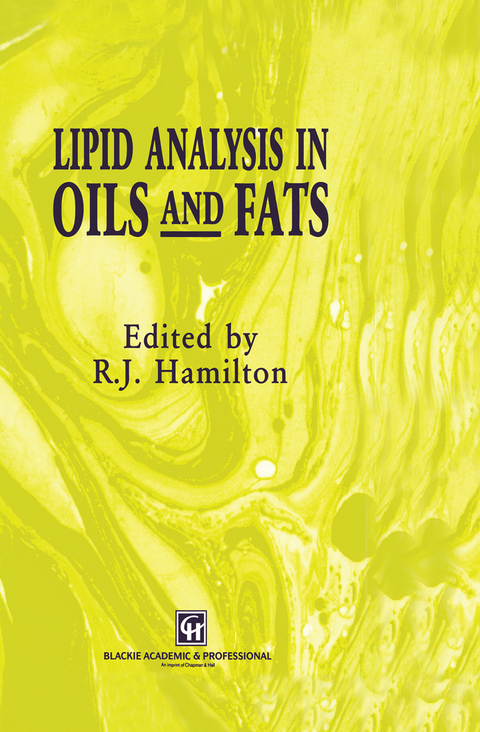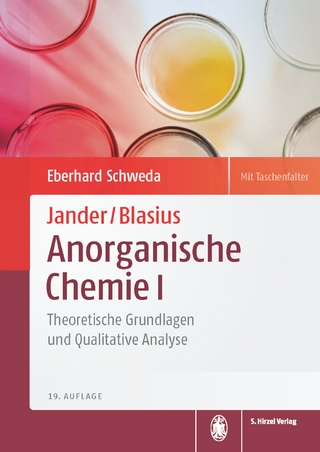
Lipid Analysis in Oils and Fats
Springer-Verlag New York Inc.
978-1-4612-8432-1 (ISBN)
AAPH 2,2'-azobis (2-aminopropane )dihydrochloride Ac acetyl AchE acetylcholinesterase analog digital converter ADC AI artificial intelligence ALD aldehyde AMPL acetone mobile polar lipids atomic mass unit amu 2,2' -azo bis-2,4-dimethy lvaleronitrile AMVN ANN artificial neural network AOCS American Oil Chemists' Society APCI atmospheric pressure chemical ionization APE N-acyl-phosphatidylethanolamine API atmospheric pressure ionization ARA arachidonic acid ASG acyl-sitosterylglyceride ASMS American Society for Mass Spectrometry ATP adenosine triphosphate BE backward elimination CAD collisionally activated dissociation 3 CBC cerebroside 1 sulphate CBO Certified Brands of Origin (applied to Italian virgin olive oils) CCD charge-coupled device CE capillary electrophoresis CFAM cyclic fatty acid monomer CI chemical ionization CID collision-induced dissociation CL cardiolipin Cn:m Hydrocarbon with n carbon atoms and m double bonds CR continuum regression d. c.
1 Lipid analysis using thin-layer chromatography and the Iatroscan.- 1.1 Introduction.- 1.2 Principles of thin-layer chromatography.- 1.3 Applications of thin-layer chromatography.- 1.4 Thin-layer chromatography-flame ionization detection for lipid analysis.- 1.5 Conclusions.- Acknowledgements.- References.- 2 Characterization of lipids by supercritical fluid chromatograpahy and supercritical fluid extraction.- 2.1 Introduction.- 2.2 Supercritical fluid chromatography.- 2.3 Supercritical fluid extraction.- 2.4 Reactions in supercritical media.- 2.5 Conclusions.- Acknowledgements.- References.- 3 Static headspace gas chromatography in the analysis of oils and fats.- 3.1 Introduction.- 3.2 Theoretical background.- 3.3 Sampling systems.- 3.4 Applications of headspace gas chromatography in lipid chemistry.- 3.5 Conclusions.- References.- 4 Multinuclear high-resolution nuclear magnetic resonance spectroscopy.- 4.1 Introduction.- 4.2 The instrument.- 4.3 Principles.- 4.4 Spectra.- 4.5 Response.- 4.6 Reproducibility.- 4.7 Calibration.- 4.8 Applications.- 4.9 Quantitative determination of phospholipids: validation of the 31P NMR method.- 4.10 Instrument details.- Acknowledgements.- References.- 5 Cyclic fatty acids: qualitative and quantitative analysis.- 5.1 Introduction.- 5.2 Naturally occurring cyclic fatty acids.- 5.3 Cyclic fatty acids formed in heated vegetable oils.- 5.4 Summary.- References.- 6 Mass spectrometry of complex lipids.- 6.1 Introduction.- 6.2 Equipment and principles of soft ionization mass spectrometry.- 6.3 Applications.- 6.4 Summary and conclusions.- Acknowledgements.- References.- 7 Chromatography of food irradiation markers.- 7.1 Introduction.- 7.2 Chemical changes in irradiated foods.- 7.3 Determination of marker substances by gas chromatography.- 7.4Determination of marker substances by high-pressure liquid chromatography.- 7.5 Conclusions.- References.- 8 Development of purity criteria for edible vegetable oils.- 8.1 Introduction.- 8.2 Materials and methods.- 8.3 Results and discussion.- Acknowledgements.- References.- 9 Analysis of intact polar lipids by high-pressure liquid chromatography-mass spectrometry/tandem mass spectrometry with use of thermospray or atmospheric pressure ionization.- 9.1 Introduction.- 9.2 Theory.- 9.3 Applications.- 9.4 Practical experiences of analysis of polar lipids by means of liquid chromatography with (tandem) mass spectrometry.- 9.5 Summary.- References.- 10 The exploitation of chemometric methods in the analysis of spectroscopic data: application to olive oils.- 10.1 Introduction.- 10.2 Olive oil.- 10.3 Data acquisition methods.- 10.4 Multivariate methods.- 10.5 Concluding remarks and future prospects.- Acknowledgements.- References.
| Zusatzinfo | XXII, 386 p. |
|---|---|
| Verlagsort | New York, NY |
| Sprache | englisch |
| Maße | 155 x 235 mm |
| Themenwelt | Naturwissenschaften ► Chemie ► Analytische Chemie |
| Technik ► Lebensmitteltechnologie | |
| ISBN-10 | 1-4612-8432-5 / 1461284325 |
| ISBN-13 | 978-1-4612-8432-1 / 9781461284321 |
| Zustand | Neuware |
| Haben Sie eine Frage zum Produkt? |
aus dem Bereich


